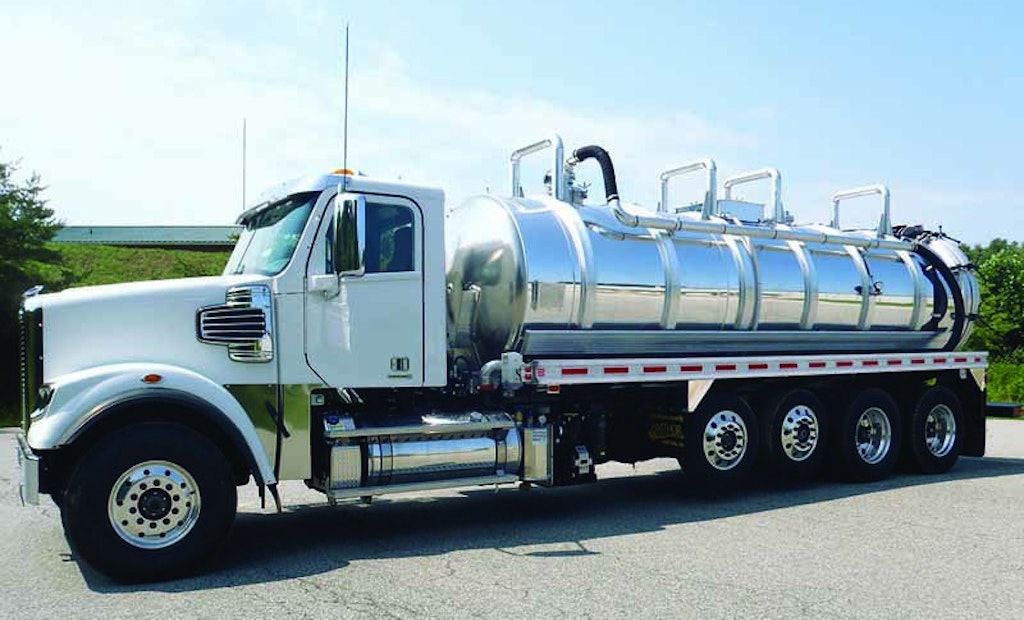Interested in Trucks?
Get Trucks articles, news and videos right in your inbox! Sign up now.
Trucks + Get AlertsAre you overweight? Not personally, but what about your truck? Is your payload pushing the limit? Might your truck be exceeding its gross vehicle weight rating (GVWR)?
GVWR is the weight your truck was built to safely carry. For a Class 7 vacuum truck it might be 33,000 pounds. Exceed that weight and you could pay a fine or face criminal charges. Being overweight strains your engine, drivetrain, brakes, axles, springs, tires and frame.
Brian Amthor, marketing director for Amthor International in Gardiner, New York, says a truck with a 10,000-pound front axle and 23,000-pound rear axle should not exceed 33,000 pounds.
“If your air-ride suspension gets abused and you’re going down the road with a broken suspension, that can cause stress cracks on your tank,” he says. “It gets to be a domino effect.”
Connecticut, Massachusetts, New York and Rhode Island enforce weight laws through fines. While they don’t explicitly provide prison terms for weight violations, Connecticut and other states have criminal statutes such as manslaughter and assault that can be used against the owner or operator of an overweight truck. Typically, these charges are brought only when the failure to comply with maximum weight restrictions causes an accident that results in death or serious injury.
First-degree manslaughter is a Class B felony punishable by 20 years in prison, a fine up to $15,000 or both. The owner or operator of an overweight truck also could be charged with manslaughter in the second degree should he recklessly cause the death of another person.
Connecticut’s Penal Code also permits charging the owner or operator of an overweight truck with reckless endangerment. First-degree endangerment is a Class A misdemeanor punishable by up to a year in prison, fine of $2,000 or both.
GVWR is established by the truck manufacturer and takes into account the base weight of the vehicle plus the weight of any accessories, passengers and cargo. It can typically be found on a label inside the door frame and shouldn’t be confused with gross vehicle weight (GVW). GVW is the total weight of the vehicle – including driver, fuel, vacuum tank and payload. While GVW constantly changes, GVWR remains the same. For safety’s sake, GVW should never surpass GVWR.
And don’t assume your truck – even a new one – is below GVWR when transporting a full load. It’s possible to build an overweight truck, although you’re more likely to purchase an overweight used truck or make a truck overweight by mounting a larger tank.
For example, say you put a 4,000-gallon tank on a 30,000 GVWR chassis. Since water weighs 8 pounds per gallon, a full payload would exceed GVWR (8 x 4,000 = 32,000 pounds) without even accounting for tank weight, driver or fuel.
When transporting a load, be aware of the legal highway weight. This is the legal weight related to highway size and weight limits. When operating on the Interstate System, the maximum permissible weight is 20,000 pounds on a single axle and 34,000 pounds on tandem axles closer than 96 inches apart. The maximum GVW cannot exceed 80,000 pounds.
With a few exceptions, the federal bridge formula establishes the maximum weight vehicle axles can carry on the Interstate System. The bridge formula was introduced in 1975 to reduce the risk of damage to federal highway bridges by requiring more axles or a longer wheelbase to compensate for increased vehicle weight.
“The weights are determined by the length of the truck that’s measured from the center of the steering axle to the center of the rearmost axle,” says Roy Coffey, sales manager at Lely Tank & Waste Solutions in Wilson, North Carolina. “The longer you get, the more weight you can put on it. A prime example is if you are 20 feet from the center of the steering axle to the center of the rearmost axle on a tandem axle truck, you’re allowed 51,000 pounds. If you are 30 feet from the center of the steering to the center of the axle, then you are allowed 58,500. If you add a lift axle to that, then at 20 feet you are allowed 55,500. At 30 feet you are allowed 62,000.”
While most states use the bridge formula for all roads, some have a separate formula for non-Interstate highways. Weight can also vary by state. For example, maximum gross vehicle weight is 85,500 pounds in Kansas and 80,000 in Missouri.
Know your limits. Maintaining a proper weight is good for you and your truck.






